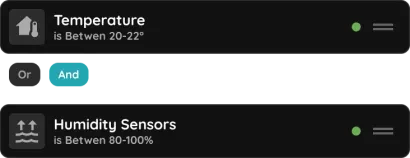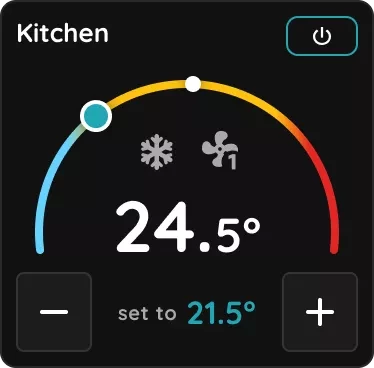On this page
Magnetic and motorized valves are essential components in HVAC systems that control the flow of hot or cold water. These valves are typically powered by electric motors, which allow precise regulation of water entering or exiting the heating and cooling systems connected to the HVAC unit.
Key Features:
1. Flow Control:
• Motorized valves open and close to regulate the flow of hot or cold water coming from the HVAC machine, ensuring the system delivers the right amount of heating or cooling.
• Magnetic valves function similarly, using electromagnetic forces to control water flow with high efficiency and accuracy.
2. Integration with Pierre:
• These valves can be integrated into the Pierre system, allowing them to be controlled automatically or manually via the Pierre app. The system ensures optimal operation, adjusting water flow based on room temperature or system demand.
3. Automation:
• Through the Pierre controller, the motorized valves can be automated to respond to various triggers, such as changes in temperature or scheduled heating/cooling times. This ensures that the HVAC system runs efficiently and only when needed, helping conserve energy.
4. Precise Regulation:
• Motorized valves offer precise control over the flow rate, ensuring that water from the HVAC system reaches the desired zones in the correct amounts, improving overall system performance and comfort.
By integrating magnetic/motorized valves into the Pierre system, users gain enhanced control over their HVAC systems, ensuring efficient and reliable management of heating and cooling across their property

| Position | Wires | Diameter | Type | Comment |
|---|---|---|---|---|
| From Relay board to Valve | 2 | 1.5 mm² | PP/Y | L, N |
| From PIERRE to Relay board | 2 | 0.75 mm² | PF | GND, OUTPUT |
What should I do if the temperature reading stays the same and doesn’t change?
If the temperature reading remains constant and does not change, it is likely that the temperature sensor has burned out. Check the sensor and replace it if necessary to restore accurate temperature readings.
Where should I place the temperature sensor for accurate readings?
For accurate temperature readings, place the sensor at the height of the expected temperature value. Avoid placing it on the floor, ceiling, or near other devices that may affect the results. A good spot is at shoulder height on a wall in an area where it can measure ambient air effectively.
Is a thermostat required?
No, a classic thermostat is not necessary. Instead, a temperature sensor integrated with the PIERRE system can monitor the room’s temperature and manage the heating/cooling devices accordingly.
Does Pierre have its own thermostat?
Yes, PIERRE offers its own smart thermostats, which can be found in the thermostat product category.
If I remove an old thermostat, can I replace it with a PIERRE display for heating control?
Yes, you can replace an old thermostat with a PIERRE display, as long as the display includes a temperature sensor for temperature monitoring.
Can a display work as a thermostat?
Yes, most Pierre displays have built-in temperature sensors and can control heating/cooling systems just like a thermostat. All displays have relays that can send signals to heating/cooling devices to turn them on or off.
Can the display relay control underfloor heating valves?
Yes, the display can control underfloor heating valves as well as other heating and cooling systems.
How can heat quantity measurement be solved with the PIERRE system?
To measure heat quantity, a PIERRE Pro Controller and an Intesis Mbus to Modbus converter are required. The heat meters are connected in series to the PIERRE Controller.
In a multi-apartment system, how should the circulation pump be controlled?
The circulation pump’s operation is based on automation, so if the valve in any apartment’s floor heating system is activated, it simultaneously activates the circulation pump. If separate control is needed, it can only be handled locally within the apartment.
Regarding heating and cooling, how can I set it up later to ensure the requested hot or cold water reaches each apartment? How can I start the circulation pump per apartment?
Starting from the apartments, the process works as follows: humidity and temperature values are measured in the apartments. To reach the desired temperature, we control the distribution manifolds in the apartments. The circulation pumps for each floor are turned on when any apartment’s distribution manifold valve is open.
How will the heat pump be connected to the PIERRE system?
The heat pump can be controlled by PIERRE in two ways:
- Winter and summer modes can be switched via a potential-free contact, and a similar contact can be used for starting and stopping the heat pump (start/stop function).
- Modbus RTU communication. It’s important to consult the manufacturer or distributor in advance about the Modbus register addresses and required documentation based on the heat pump model to ensure the proper control process.
Can I adjust different temperatures in different rooms?
Yes, you can control the temperature room by room.
Can we program PIERRE so that the valve opens at a given temperature and the pump starts in the valve open position?
Yes, this can be solved per manifold. Alternatively, PIERRE can be programmed so that the valve opens at a certain temperature and the pump starts when the valve is in the open position.
What equipment can be controlled by the PIERRE system for starting heat pumps, hot water tanks, and motorized valves in underfloor heating zones?
The motorized valves for underfloor heating zones can be controlled without any issues by the PIERRE system, whether they are On-Off or 0-10V valves. In the mechanical room, the PIERRE system handles the following controls: winter-summer mode switching via a potential-free contact, circulation pump control, hot water circulation pump control, and 0-10V mixing valve control with supply water temperature measurement.




